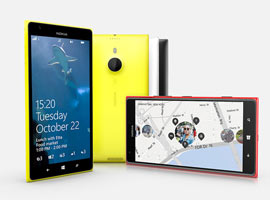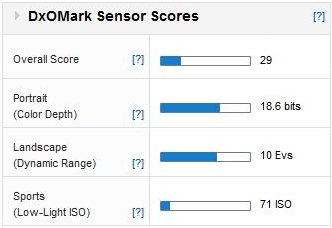Introduction
While rivals such as Apple and Samsung along with the raft of dedicated photography apps have advanced the popularity of the smartphone as an more convenient option to a digital stills compact camera it is, arguably, Nokia with its Pureview technology and specifically the 38-Mpix 808 model that has elevated the humble camera phone to the status it has today.
The 808 and the Windows Phone based Lumia 1020 have performed well in our tests, the 808 Pureview in particular.
The latest top-of-the-range model, the WP8 Lumia 1520, eschews the physically larger 1/1.5 in type (6.6 x 8.8mm) BSI CMOS of the Lumia 1020 for a smaller, more conventional (4.3 x 5.8mm) 20-Mpix BSI CMOS with a maximum sensitivity of ISO4000 and a slimmer profile, not unlike that of the Lumia 925.
Like the 1020, the 1520 offers a down-sampled 5-Mpix Jpeg for sharing, as well as a native res (18.7-Mpix) still as either a JPEG or Raw file (DNG). The lens remains a stabilized autofocus 26mm 6-element model but with a slightly slower f2.4 aperture (down from f2.2).
The 1520 also sports both Nokia’s Pro Camera and Smart Camera apps in one new Camera app, making it one of the best of its type. Video enthusiasts will also be pleased to hear that the 1520 now has four mics in addition to the choice of either 1080p or 720p with the option of 24, 25 and 30fps framing rates.
The headline news, is arguably not the camera module, but the inclusion of a 6.0in IPS LCD that makes the new addition to the range clearly aimed at rival Samsung’s Galaxy Note III. Microsoft’s support for a Full HD (1920×1080) panel is welcome but at 162.8 x 85.4 x 8.7mm it’s still a large camera-phone for photography, even if it’s still a reasonably light 209g.
It also adopts Corning’s Gorilla Glass 2 instead of the more scratch resistant Glass 3 variant used on the 1020 model. The Lumia 1520 is available now SIM free for around $610.
For more information on the 38-Mpix Nokia Lumia 1020, please see our review: Nokia Lumia 1020 sensor review: Are mobiles comparable to compacts and DSLRs?
Nokia Lumia 1520 sensor performance: Disappointing low-light capabilities
A DxOMark lens score of 29 points is around the expected value for a camera-phone sensor like this. It’s behind the physically larger 38-Mpix device used in the Lumia 1020 but if we look at the individual metrics, particularly the color depth at 18.6 bits and dynamic range of 10Ev, they’re pretty good.
In good light, the Lumia 1020 will be pretty good performer, however, as expected, the low-light score is the weakest link in the imaging chain. At 71 ISO it’s somewhat disappointing, though in fairness it’s unlikely to be worse than rivals with similar sensors.
Nokia Lumia 1520 Versus Nokia Lumia 1020: Competitive in good light
Compared with the firm’s Lumia 1020, the only other smartphone in our database courtesy of its Raw data output, the Lumia 1520 falls someway behind that model in overall sensor performance.
However it compares closely in terms of color discrimination and dynamic range, only it’s clearly outshone by the larger sensor of the Lumia 1020 despite the same pixel pitch, with around +1 stop in low-light capability. At least, that’s the case when ‘normalized’ for print. If we compare the data in ‘screen mode’, at 100% magnification on a computer screen, the two sensors perform similarly.
Nokia Lumia 1520 Versus Nikon 1 V3
When viewed against the 1-inch non-BSI CMOS sensor of the recently evaluated Nikon 1 V3, which didn’t perform quite as well as we expected, Nokia is making ground even with the Lumia 1520.
Admittedly, the larger Nikon sensor has phase-detection AF capabilities and still has +2.2 bits improved color discrimination at base ISO; the +0.7 Evs advantage in dynamic range is slight. The +2 stop advantage in Low-light ISO capability is significant however, and proves there’s still some way to go before camera-phones can match the potential of cameras with larger sensor.
Conclusion
As one of the few camera-phone models that outputs a Raw file (DNG), the Lumia 1520, like the earlier 1020, is an interesting development for DxO Labs, as it allows us the opportunity to assess the sensor using the same industry-level image quality measurements as we do for cameras. We hope other maker’s will follow Nokia’s lead.
In the event, the physically small sensor used in the Lumia 1520 is somewhat restricting in terms of imaging performance.
Limitations are noticeable even under ideal lighting conditions, though the Lumia 1520 should provide pleasing images all the same. Under indoor lighting this will prove more challenging, but, despite those few reservations, the Lumia 1520 remains an attractive option.










DXOMARK encourages its readers to share comments on the articles. To read or post comments, Disqus cookies are required. Change your Cookies Preferences and read more about our Comment Policy.